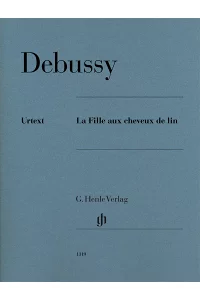Debussy, Claude Achille : Préludes 1
Work Overview
Publication Year:1910
First Publisher:Durand
Instrumentation:Piano Solo
Genre:pieces
Total Playing Time:37 min 00 sec
Copyright:Public Domain
Commentary (2)
Author : Shiraishi, Yuriko
Last Updated: January 27, 2020
[Open]
Author : Shiraishi, Yuriko
General Introduction
Debussy's Préludes, comprising 24 pieces across two books, is considered to have been influenced by Chopin's 24 Préludes. This first book, written prior to the second, was composed in a very short period of approximately two months, from December 7, 1909, to February 4, 1910. The premieres of excerpts began sequentially in May 1910, and the complete set of 12 pieces was performed by Jane Mortier on May 3, 1911. Unlike Chopin's Préludes, each piece concludes with an allusive and suggestive title in parentheses. This is considered to be the composer's deliberate arrangement to free performers and listeners from any poetic intentions by not placing the titles at the beginning, thus not hindering their imagination. On the other hand, the presence of detailed performance indications within the pieces suggests Debussy's earnest attempt to convey his musical concepts through the score. Performers will constantly be required to interpret these indications and express them as sounding music. For the explanations of each piece, the title will be noted at the beginning, though this may not strictly align with the composer's original intention.
Explanations of Each Piece
No. 1: “Danseuses de Delphes”
“Danseuses de Delphes” refers to a Greek sculpture depicting three priestesses of Bacchus (Dionysus), which Debussy admired. The first section (measures 1-10) consists of two five-measure subsections. The first episode comprises five measures: two slow, sarabande-like measures with an accent on the second beat, followed by three measures consisting of a dotted melody and parallel chords. The second episode is a recapitulation of the first, presented an octave higher in pitch and showing development. The second section (measures 11-24) is structured as a transition of four episodes: the first episode (measures 11-14) with a dotted melody and parallel chords moving over a sustained tonic bass, the second episode (measures 15-17) highlighting a dotted melody in the inner voice, the third episode (measures 18-20) increasing in quietness towards ppp, and the transitional fourth episode (measures 21-24). The third section (measures 25-31) functions as a coda, recalling the opening of the piece before concluding.
【Musical Example 1: Opening】[1]
【Musical Example 2: Opening of Section 2, measures 11-12】
【Musical Example 3: Opening of Section 3, measures 25-26】
No. 2: “Voiles”
The title Voiles can be interpreted as either “sails” (feminine plural) or “veils” (masculine). Particularly, the light and soft parallel third chord motif in the opening four measures (Musical Example 1) exhibits a character that suits either interpretation of the title. The B-note bass melody appearing from measure 5 and the three-note motif “A♭-B-C” in measure 7 (Musical Example 2), along with the parallel third chord motif, become the main motifs of the four episodes that constitute the middle section. While the B♭ bass melody constantly resonates, the small undulation created by variations of the three-note motif in the first episode (measures 23-32) grows larger, spanning two octaves in the second episode (measures 33-41), becomes dynamic with rapid arpeggios interwoven in the third episode (measures 42-47), and regains quietness with glissando-like ornamentation in the fourth episode (measures 48-57). From measure 58, the parallel third chords return, and the piece concludes in a softened atmosphere.
【Musical Example 1: Opening】
【Musical Example 2: Measures 5-9】
No. 3: “Le vent dans la plaine”
Debussy composed the song En sourdine (the first song of Ariettes oubliées) based on a poem by Verlaine in 1887, where he used the verse “Le vent dans la plaine suspend son haleine” [1] by the playwright Charles-Simon Favart (1710-1792) as an epigraph. Under the instruction “as light as possible,” a main motif with a dotted rhythm emerges from a continuous series of rushing arpeggios, and in the next moment, a succession of chords descends like falling leaves (measures 1-12). Here, the opening arpeggio and dotted rhythm motif briefly return (measures 13-27), but the insertion of chordal attacks adds dynamism to the piece (measures 28-34). From measure 34, the arpeggio and dotted rhythm motif return, and the piece concludes with a floating sensation, like a gentle breeze.
No. 4: “Les sons et les parfums tournent dans l'air du soir”
The title is a quotation from “Harmonie du soir” (Evening Harmony), a poem included in Charles Baudelaire's (1821-1867) collection Les Fleurs du mal. Debussy had already composed a song based on this poem in 1889, but this time, he may have sought to express the poem's worldview solely through the piano. Despite being notated in 3/4 time, the opening motif (measures 1-4) is instructed to be perceived in 5/4 time with the addition of a 2-beat feel (Musical Example 1). Similarly, a 5-beat phrasing is hinted at in measures 24-26, where the opening motif is recapitulated. Furthermore, in conjunction with the appearance of fragments of the opening motif, measures 31 and 33 are changed to 4/4 time without explicit instruction (Musical Example 2). This deliberate disruption of the 3/4 time signature seems to correspond not only to the scene of the floating atmosphere but also to the keywords “valse mélancolique” (melancholy waltz) and “vertige langoureux” (languorous dizziness) from the original poem.
【Musical Example 1: Opening】
【Musical Example 2: Unindicated change to 4/4 time, measures 31, 33】
No. 5: “Les collines d'Anacapri”
Anacapri is the name of a town on the Italian island of Capri, but its connection to Debussy's inspiration remains unclear. The piece as a whole can be understood in a three-part form. The first section begins with two main motifs: the six-note first motif “B-F#-C#-E-G#-B” (measures 1-2) and the second motif, resembling distant bird chirps (measures 3-4) (Musical Example 1). This motif is repeated (measures 5-7), and a joyful melody based on the second motif is played lightly with arpeggios (measures 8-31). Eventually, a folk-like melody derived from the first motif quietly appears in the bass, then shifts to the upper voice and builds in intensity (measures 32-48). In the second section, a Habanera-like rhythm, “ta-ta-ta-TA-TA,” also found in “La Puerta del Vino” (Book 2, No. 3), is added to the melody, emphasizing the folk element (measures 49-62) (Musical Example 2). However, from measure 63, the opening six-note motif slowly and quietly returns (measures 63-65), connecting to the third section. Here, the staccato melody and folk-like melody reappear in a shortened form, and finally, the two opening motifs are fragmentarily recalled, concluding with a dazzling Southern European light (measures 66-96).
【Musical Example 1: Opening】
【Musical Example 2: Habanera-like rhythm, measure 53】
No. 6: “Des pas sur la neige”
While the origin of the title is unknown, it is suggested that it may have influenced later works, given that Maurice Leblanc published a novel with the same title in 1923. At the beginning, there is an instruction: “This rhythm must have the sonorous value of a sad and frozen landscape.” Over a dragging rhythm, the upper voice melody is played with poignancy (Musical Example). In measures 8-15, a bass melody is added in place of the upper voice melody, making the dragging rhythm particularly prominent. Thereafter, melodies are added to both the upper and lower voices, but the dragging rhythm dominates the piece until the end, creating a dark and ponderous musical character.
【Musical Example: Opening】
No. 7: “Ce qu'a vu le vent d'ouest”
This piece, said to be derived from a character in Hans Christian Andersen's fairy tale The Garden of Paradise (French translation published in 1907) or from Percy Bysshe Shelley's “Ode to the West Wind,” possesses the most tempestuous character within this collection. Given the dizzying shifts in passages that make its structure difficult to grasp, it should be performed with careful attention to the performance indications. The opening begins with arpeggios marked pp in volume, yet given active and tumultuous performance indications. These arpeggios occasionally transform into distant groans, gradually gaining momentum and reaching the first peak of the storm from measure 23. The anxiety-inducing tremolos and arpeggios continue, reaching a second peak in measures 35-42 and a third peak in measures 47-53. After the raging arpeggiated winds in measures 57-58, a brief lull is followed by strong winds raging again at the end.
No. 8: “La fille aux cheveux de lin”
This piece is said to be derived from an unpublished song of the same name, composed around 1882, based on a poem by Leconte de Lisle. It is structured in three parts, marked by the main motif of the opening four measures in G-flat major. In the first section, the opening motif temporarily cadences in E-flat major in the subsequent phrase (measures 5-7). In the second section, an extended opening motif (measures 8-13) is followed by a secondary motif (measures 14-16) whose melody is supported by a dotted rhythm imitation, leading to a development in four episodes. The first descending episode (measures 17-18), the second ascending and building episode (measures 19-21), and the third episode relaxing from a peak (measures 22-23) are followed by the fourth episode (measures 24-27), which quietly sways with parallel chords, remaining on the dominant chord (Musical Example). It does not resolve to the tonic chord but connects to the subdominant, initiating the third section. The latter half of the opening motif is expanded (measures 28-32), and it quietly and slowly fades away with the whisper of the secondary motif (measures 33-39).
【Musical Example: Connecting section from Section 2 to Section 3, measures 27-30】
No. 9: “La sérénade interrompue”
The exact origin of the title is unknown. However, the opening motif with musical ideas suggesting guitar tuning (Musical Example 1), and the quotations within the piece from Albéniz's “El Albaicín” (from suite Iberia, Book 3, No. 1, 1905-1908) (measures 19-24, 41-45, 85-86, 90) (Musical Example 2), as well as from Debussy's own work (from “Le matin d'un jour de fête,” the third part of “Ibéria,” the second piece of Images pour orchestre, 1905-1908) (measures 80-84, 87-89) (Musical Example 3), serve as strong materials connecting the piece to Spain. The pleading serenade is frequently interrupted by these motifs, and finally completely cut off.
【Musical Example 1: Opening】
【Musical Example 2: Quotation from Albéniz's “El Albaicín,” measures 19-24】
【Musical Example 3: Quotation from “Le matin d'un jour de fête,” measures 80-84】
No. 10: “La Cathédrale engloutie”
This piece is said to be inspired by the legend of Ys, a city submerged off the coast of Brittany. In a deeply silent sea, a gentle mist of sound rises from ascending chords composed of perfect fifths and fourths (measures 1-6), and the bells of the submerged cathedral slowly resonate (measures 7-13). As the bass begins to move with arpeggios, the mist gradually clears, and the cathedral begins to emerge from the sea (measures 16-27), appearing fully above the water with a powerful and weighty ff sound (measures 28-46). From within the cathedral, the chanting of monks is heard as a modal melody, but the cathedral is once again swallowed by the sea (measures 47-71). The lingering resonance of the cathedral's brief reappearance echoes the phrase from measure 28 (measures 72-83), and the quiet sea, once misty, returns with faintly audible bell sounds (measures 84-89).
No. 11: “La danse de Puck”
This piece is said to be inspired by A Midsummer Night's Dream with illustrations by the English painter Arthur Rackham (1867-1939), published in 1908, while also being influenced by Rudyard Kipling's (1865-1936) Puck of Pook's Hill, published in 1906. The opening dotted motif is presented lightly and capriciously, as if depicting the dance of the fairy Puck (measures 1-17) (Musical Example 1). In the middle section, a soft and gentle atmosphere is emphasized more than comicality, through a two-beat dance with grace notes (measures 18-31) and a subsequent three-beat dance (measures 32-48) (Musical Example 2). The opening motif, after fragmentary presentations (measures 57-62), is recapitulated in its complete form at measure 63, but with a transitional passage inserted that was not present at the beginning, showing free development. From measure 87, a coda based on the recollection of the opening motif begins, and Puck vanishes with an ascending scale.
【Musical Example 1: Opening】
【Musical Example 2: Two-beat dance, measures 16-20】
No. 12: “Minstrels”
The title originates from a minstrel show Debussy saw during his visit to Eastbourne in southern England in the summer of 1905. Minstrel shows were popular entertainment from the mid to late 19th century, featuring white performers in blackface who sang, danced, and performed skits. Following the awkward rhythmic opening (measures 1-8), a propulsive episode appears (measures 9-18). The two-measure melody in measures 11-12 of this episode (Musical Example) becomes an important motif connecting the rapid two-beat episode (measures 28-31), the mocking low-register episode (measures 35-44), and the lyrical episode (measures 63-74). From measure 78, the opening rhythmic motif returns, and from measure 87 to the end, the two-measure motif recurs, bringing the piece to a close.
【Musical Example: Two-measure motif, measures 11-12】
[1] Matsuhashi, Mari. 2007. Debussy (“Composer and Person Series”). Tokyo: Ongaku no Tomo Sha, p. 168.
[1] The scores used in this commentary are as follows.
Claude Debussy. 1910. Préludes. Livre 1, Paris: Durand et Cie, D. & F. 7687, accessed 15 December 2019, International Scores Music Library Project, http://conquest.imslp.info/files/imglnks/usimg/c/c0/IMSLP00509-Debussy_-_Preludes,_Book_1.pdf.
Author : PTNA Piano Encyclopedia Editorial Department
Last Updated: January 1, 2010
[Open]
Author : PTNA Piano Encyclopedia Editorial Department
While Estampes was the first work to establish Debussy's so-called "Impressionistic" style in piano music, it can be said that this collection of two books of Préludes further developed it to a state of completion. Consequently, all the pieces in this collection are masterpieces that showcase Debussy's unique individuality.
The 12 pieces of Book I were composed between 1909 and 1910. The titles of each piece were written in small print in the margin at the end of each piece, a consideration by Debussy to prevent listeners from being constrained by preconceived notions.
1. Danseuses de Delphes / "Danseuses de Delphes"
This piece softly depicts a dance dedicated to the gods at the ruins of the famous Temple of Apollo in Delphi, an ancient Greek city. It is said to have been composed with inspiration from sculptures in the Louvre Museum.
2. Voiles / "Voiles"
This piece, which Debussy himself described as having a "supple and caressing rhythm," skillfully employs the whole-tone scale to exquisitely express gently undulating waves and wind.
3. Le vent dans la plaine / "Le vent dans la plaine"
The wind blows quietly, sometimes a little strongly, across the plain. Such moments of nature are meticulously depicted.
4. Les sons et les parfums tournent dans l'air du soir / "Les sons et les parfums tournent dans l'air du soir"
The title is taken from a line in Baudelaire's poem "Harmonie du soir" (Evening Harmony). A languid and melancholic mood flows through an indeterminate rhythm.
7. Ce qu'a vu le vent d'ouest / "Ce qu'a vu le vent d'ouest"
The west wind in France is usually strong, and its fierce raging is expressed with technical boldness.
8. La fille aux cheveux de lin / "La fille aux cheveux de lin"
This piece was composed under the influence of the poem of the same name from Leconte de Lisle's poetry collection Chansons écossaises (Scottish Songs). In this poem, "The Girl with the Flaxen Hair" is described as "a beautiful girl with cherry-red lips, singing of love with the larks, bathed in the bright summer sun."
10. La cathedrale engloutie / "La cathedrale engloutie"
It is said to be based on a Celtic legend passed down in Brittany. This legend tells of a cathedral swallowed by the sea that rises above the waves, beginning with the quiet sound of bells echoing in the sea, and culminating in a powerful surge as the cathedral majestically emerges.
Movements (12)
"Les sons et les parfums tournent dans l'air du soir"
Total Performance Time: 3 min 30 sec
PTNA & Partner Channel Videos(92items) View More
Sheet MusicView More
Scores List (103)

(株)全音楽譜出版社

(株)全音楽譜出版社

(株)ドレミ楽譜出版社

(株)春秋社

(株)音楽之友社

(株)全音楽譜出版社

(株)全音楽譜出版社

(株)全音楽譜出版社

(株)ヤマハミュージックエンタテインメントホールディングス

(株)音楽之友社

KMP(ケイ・エム・ピー) ケイエムピー

ミュージックランド

ハンナ(ショパン)

(株)ドレミ楽譜出版社

(株)リットーミュージック

KMP(ケイ・エム・ピー) ケイエムピー

ミュージックランド

ミュージックランド

(株)シンコーミュージックエンタテイメント

ミュージックランド

(株)シンコーミュージックエンタテイメント

(株)シンコーミュージックエンタテイメント

(株)リットーミュージック

(株)オンキョウパブリッシュ〇

ミュージックランド

KMP(ケイ・エム・ピー) ケイエムピー

ミュージックランド

(株)ヤマハミュージックエンタテインメントホールディングス

(株)ドレミ楽譜出版社

(株)シンコーミュージックエンタテイメント

(株)ドレミ楽譜出版社

(株)ドレミ楽譜出版社

(株)シンコーミュージックエンタテイメント

ミュージックランド

ミュージックランド

(株)シンコーミュージックエンタテイメント

ミュージックランド

(株)ドレミ楽譜出版社

(株)全音楽譜出版社

(株)リットーミュージック

(株)ヤマハミュージックエンタテインメントホールディングス

ハンナ(ショパン)

ハンナ(ショパン)

ハンナ(ショパン)

ミュージックランド

(株)ドレミ楽譜出版社

(株)シンコーミュージックエンタテイメント

(株)シンコーミュージックエンタテイメント

ハンナ(ショパン)

(株)ドレミ楽譜出版社

(株)ドレミ楽譜出版社

(株)シンコーミュージックエンタテイメント

(株)シンコーミュージックエンタテイメント

ハンナ(ショパン)

ハンナ(ショパン)

ハンナ(ショパン)

KMP(ケイ・エム・ピー) ケイエムピー

KMP(ケイ・エム・ピー) ケイエムピー

KMP(ケイ・エム・ピー) ケイエムピー

(株)ドレミ楽譜出版社

(株)全音楽譜出版社

(株)ヤマハミュージックエンタテインメントホールディングス

ミュージックランド

(株)ヤマハミュージックエンタテインメントホールディングス

ミュージックランド

(株)ドレミ楽譜出版社

デプロMP

ミュージックランド

ミュージックランド

(株)全音楽譜出版社

(株)全音楽譜出版社

(株)全音楽譜出版社

(株)ドレミ楽譜出版社

ミュージックランド

(株)シンコーミュージックエンタテイメント

KMP(ケイ・エム・ピー) ケイエムピー

(株)オンキョウパブリッシュ〇

(株)ドレミ楽譜出版社

ミュージックランド

(株)ドレミ楽譜出版社

(株)ヤマハミュージックエンタテインメントホールディングス

KMP(ケイ・エム・ピー) ケイエムピー

ミュージックランド

(株)レッスンの友社

KMP(ケイ・エム・ピー) ケイエムピー

ヘンレ社(ヤマハ)

ヘンレ社(ヤマハ)

デュラン社

(株)全音楽譜出版社

(株)リットーミュージック

(株)ヤマハミュージックエンタテインメントホールディングス

(株)ヤマハミュージックエンタテインメントホールディングス

Neil A. Kjos Music Company

Neil A. Kjos Music Company

Musikverlag Doblinger

Peters

(株)ヤマハミュージックエンタテインメントホールディングス

























